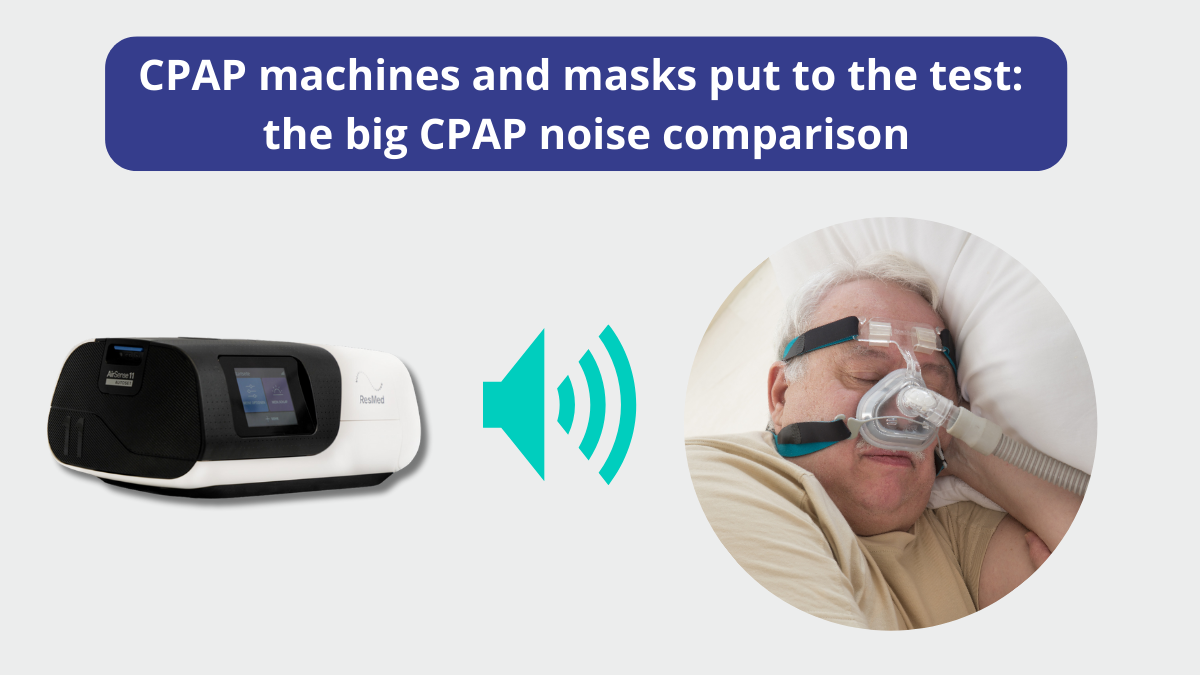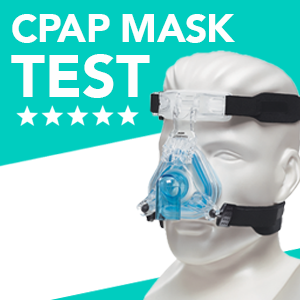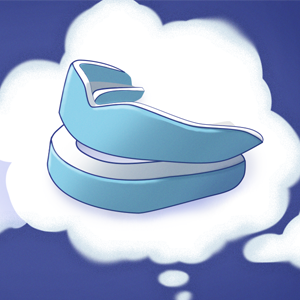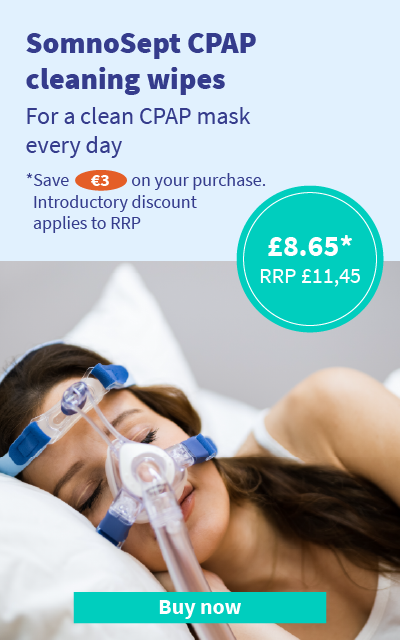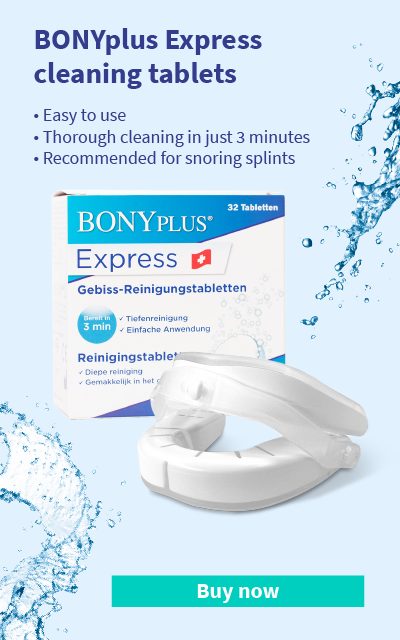Years of product consulting have shown us just how important the issue of volume is for a lot of patients. One of the most common questions we hear is: ‘Are CPAP machines noisy?’ After all, adjusting to a CPAP device is enough to contend with in itself, without also having to deal with disturbed sleep due to irritating noises. But just how loud are CPAP masks and devices really, and what are the contributing factors?
The two key values you need to know about CPAP noise
To get a clearer picture, we’ve had a look at the manufacturers’ information on CPAP machine and CPAP mask noise levels for you. But before we get into the details, there’s something that’s really important to understand:
There are two key terms that are commonly used when talking about volume in CPAP devices and masks: namely “sound power level” and “sound pressure level”:
- Sound power level: this tells us the entire sound energy emitted by a noise source, regardless of the distance from the source. It is therefore a fixed device property.
- Sound pressure level: this tells us what we actually hear, and what is recorded with the sound level meter. It is heavily dependent on the distance from the noise source and the environment.
“Sound power level” is therefore the more suitable value for an objective comparison between both CPAP devices and CPAP masks, which is why we have used this value in our major comparison based on manufacturer information. HOWEVER: If you want to know how the individual CPAP device or CPAP mask is likely to affect you, then “sound pressure level” is the more relevant value. This is why we always display both values in our shop; one to compare the products (sound power level) and one to show how loud you will find the individual device (sound pressure level).
The comparison: what makes more noise than your CPAP?
Here are a few references to give you a better idea of how loud the CPAP device or CPAP mask really is:
| Noise source | Sound power level (L_W) | Sound pressure level (L_p) |
| Quartz watch ticking | 15–25 dB(A) | 20–30 dB(A) (0.1 m distance) |
| Computer fan (low speed) | 25–35 dB(A) | 25–40 dB(A) (0.5 m distance) |
| Fridge (standard) | 40–45 dB(A) | 30–45 dB(A) (1–3 m distance) |
| Dishwasher (quiet mode) | 45–55 dB(A) | 40–55 dB(A) (1 m distance) |
| Laser printer (during printing operation) | 55–65 dB(A) | 50–60 dB(A) (1 m distance) |
There’s one thing we can tell you already: the CPAP masks and CPAP devices available on the market are no louder than computer fans running at low speed, and a lot of CPAP masks are in the same volume range as the ticking of a quartz watch. So we’re generally talking about a really low noise level here.
An astonishing comparison: modern CPAP devices really are consistently that quiet
But there must be differences even at this low level, right? Well, this isn’t really the case for CPAP devices, as we can see from a comparison of common CPAP devices:
| Manufacturer | Model | Sound power level_dBA |
| ResMed | AirSense 10 Autoset | 33 |
| ResMed | AirSense 11 | 33 |
| ResMed | S9 | 34 |
| Philips | DreamStation 1 | 35 |
| Philips | DreamStation 2 | 35 |
| Löwenstein | Prisma Smart | 34 |
| Löwenstein | Prisma Soft | 35 |
| Löwenstein | Prisma 20A, 25S, 25ST | 34.5 |
| Löwenstein | Prisma 30ST | 36 |
What this table clearly shows is that there is barely any noteworthy difference between the CPAP devices: they are all very quiet (no louder than a computer fan running on low). Newer models aren’t necessarily quieter than older models, as shown by the comparison between the latest ResMed model (Airsense 11) and its predecessor (Airsense 10). ResMed has a slight edge in terms of noise reduction, but not so much as to make a noteworthy difference – it’s a really even playing field.
QuietAir makes the difference: ResMed dominates in the field of quiet CPAP masks
With CPAP masks, on the other hand, there are more significant differences. We have evaluated the manufacturer information for 44 CPAP masks from leading manufacturers ResMed, Philips, Löwenstein and Fisher & Paykel. The sound power level of the masks was very varied, ranging from around 20 dB to 34 dB.
The quietest masks were the nasal pillow masks, and there was barely any difference between nasal masks and full-face masks:
Sound level by category
| Category | Average sound level |
| Nasal pillow mask | ~22.4 dB(A) |
| Full-face mask | ~25.6 dB(A) |
| Nasal mask | ~25.3 dB(A) |
So which manufacturer makes the quietest CPAP masks?
Well, the answer is clear if you look at the 10 quietest CPAP masks in our evaluation:
| Device name | Manufacturer | Sound power level | Category |
| AirFit F40 QuietAir | ResMed | 20 | Full-face mask |
| Löwenstein Lena | Löwenstein | 20 | Full-face mask |
| AirFit P30i | ResMed | 21 | Nasal pillow mask |
| AirFit P10 | ResMed | 21 | Nasal pillow mask |
| AirFit N30i QuietAir | ResMed | 21 | Nasal mask |
| AirFit F30 QuietAir | ResMed | 21 | Full-face mask |
| AirFit F20 QuietAir | ResMed | 21 | Full-face mask |
| Eson 2 (with diffuser) | Fisher & Paykel | 21 | Nasal mask |
| Löwenstein JOYCEeasy Full Face | Löwenstein | 23 | Full-face mask |
| Airfit N20 | ResMed | 24 | Nasal mask |
ResMed very clearly dominates the field here; only three masks are from other manufacturers (namely Löwenstein and Fisher & Paykel). It’s worth pointing out here that thanks to its QuietAir technology, ResMed has also managed to make nasal masks and full-face masks (which tend to be louder) much quieter.
This technology undoubtedly puts ResMed in first place when it comes to the volume of CPAP masks. Following closely behind in second place is Löwenstein, with its compact field of quiet CPAP masks.
The brand’s advantage can clearly be seen from the further evaluation of the masks based on minimum/maximum and average values for each manufacturer:
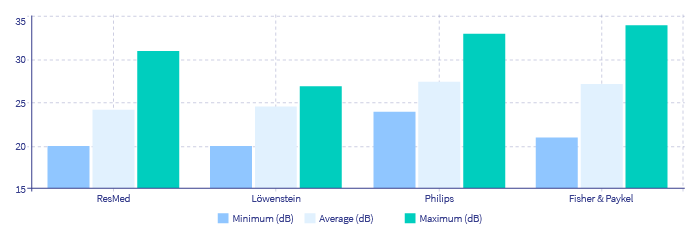
Compared to ResMed, Löwenstein has a slightly higher average volume (24.6 dB compared to 24.2 dB), but its loudest CPAP mask has a volume of just 27 dB (ResMed: 31 dB).
When it comes to average values, Philips and Fisher Paykel lag well behind the frontrunners (with 27.4 dB and 27.3 dB), although Fisher Paykel does have one mask in its portfolio (the Eson2) that ranks among the 10 quietest CPAP masks in our evaluation. The Eson2’s diffuser mirrors the QuietAir technology from ResMed: in both cases, a cushion acting as a filter is positioned at the outlet for the exhaled air.
Summary
When it comes to CPAP devices, it’s not usually worth paying too much attention to the volume: There’s no noteworthy difference between CPAP devices of the leading manufacturers, which are all very quiet.
With CPAP masks, on the other hand, it may be worth taking a closer look at noise levels. Masks from ResMed and Löwenstein come out on top here, with nasal pillow masks tending to be particularly quiet.
A final point: Although noise levels are certainly an important selection criterion, it shouldn’t be the only one. After all, even the loudest CPAP masks are only slightly louder than a quartz watch. Additional important selection criteria that shouldn’t be forgotten about include sleeping position or ventilation pressure.
Unsure which CPAP mask is right for you? If so, we’d recommend taking our CPAP mask test!
This unique CPAP mask test compares the most popular masks on the market
The most important purchasing criterion for mask wearers; comfort, freedom of movement and far more, coherently summarised especially for you.
What Are the Alternatives to Sleep Apnoea Masks?
Do you suffer from side effects as a result of wearing a sleep apnoea mask? In this article we inform you of alternative therapeutic options available to treat your sleep apnoea.
Dr. Daniel Grätz is the Managing Director of health.On Ventures GmbH, one of Germany’s leading online providers of snoring mouth guards, and has been providing customers with advice about these devices for many years.


